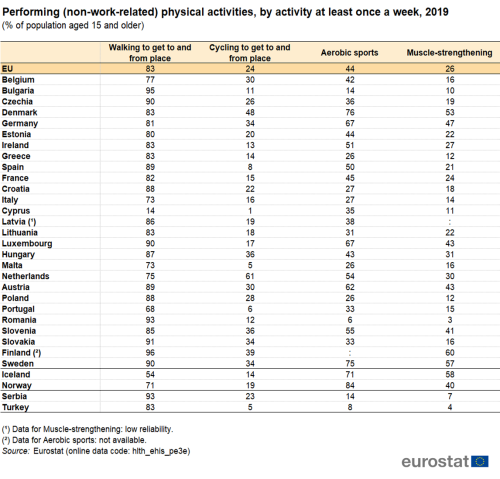Leisure time physical activities
This covers all physical activity performed outside of work, including travelling under your own steam (walking, cycling, etc.), or moving as part of a sporting activity. Both moderate and vigorous activity improve our health. The activities included in wave 3 of the EHIS survey refer to at least 10 minutes per week of:
- walking or cycling – as modes of transport (not for pleasure)
- aerobic sport, fitness or recreational activity
- muscle-strengthening activity.
According to the survey, in 2019 the most popular way of exercising outside of working hours in the EU was:
- walking as a mode of transport (to get to and from a place) (83 % of population)
- aerobic sports (44 %)
- muscle-strengthening (26 %)
- cycling as a mode of transport (to get to and from a place) (24 %).
Finland recorded the highest participation both for walking and muscle-strengthening, involving 96 % and 60 % of the population respectively (see Table 1). Travelling by bike had the highest percentage in the Netherlands (61 %) and aerobic sports were most popular in Denmark (76 %).
(% of population aged 15 and older)
Source: Eurostat (hlth_ehis_pe3e)
Active participation in sport, fitness or recreational (leisure) physical activities
Practising sport positively influences our personal health and well-being. In addition, team sports foster players’ communication skills and build team spirit and self-confidence. Achieving a sport or fitness goal can also motivate to pursue other goals. Each person’s participation in sport is affected by many factors, such as gender, age and economic situation — these aspects are analysed here based on the EHIS results.
Sports activities slightly increased between 2014 and 2019
Sport statistics only take non-work-related physical activities into account. These include sport, fitness and recreational (leisure) physical activities that cause at least a small increase in breathing or heart rate, such as: Nordic walking, brisk walking, ball games, jogging, cycling, swimming, aerobics, rowing, badminton, etc.
In 2019, 44 % of the EU population aged 15 or over reported that they have practised sport at least once a week (see Figure 1). This figure is slightly higher than in 2014 during the previous EHIS survey. Among the 24 EU countries with data available for both surveys, this increase was confirmed in 16 countries, most notably in Hungary and Estonia with almost 10 percentage points (pps).

(% of population aged 15 and older)
Source: Eurostat (hlth_ehis_pe3i)
In general, women practise sport less than men, but there are exceptions
In the EU as a whole, in 2019 more men (47 %) than women (42 %) exercised regularly (see Figure 2). The gender gap was particularly noticeable in Bulgaria, Spain, Greece and Slovakia with a difference of almost 10 pps. In Bulgaria and Romania, few people practised sport in general and the percentage of men was double that of women.
On the other hand, in the 5 EU countries where participation in sport was most common (Denmark, Sweden, Germany, Luxembourg and Austria), the percentage of women who practise sport and engage in leisure activities was either higher or almost equal to the one for men. The highest gender gap in favour of women was recorded in Denmark (5 pps).
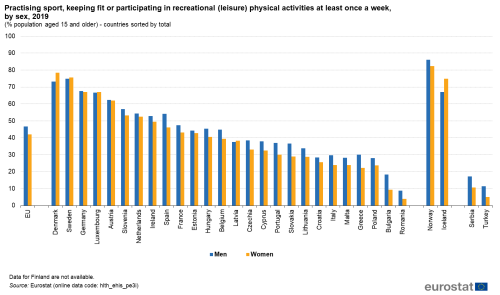
(% of population aged 15 and older)
Source: Eurostat (hlth_ehis_pe3i)
Older people in some Member States are sportier than young people in others
In general, as we get older we practise less sport and our physical activity decreases. In 2019, the percentage of people in the EU practising at least once a week ranged from 65 % among 15-24-year-olds to 31 % in the 65+ age group (see Table 2). The biggest gaps were recorded in Greece and Slovenia (57 and 56 pps respectively), and the smallest (7 and 11 pps) in Cyprus and Denmark.
In Denmark, Sweden, Luxembourg and Germany, a majority of people aged 65 and older still exercised regularly and were physically active. Their participation rate was higher than the one observed for young people in several other EU countries.
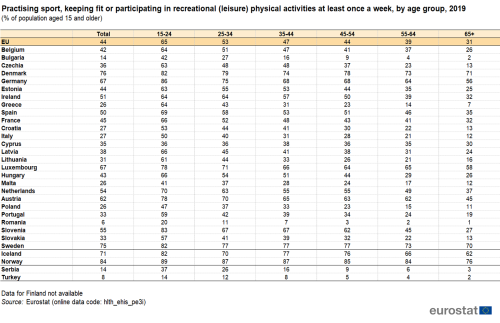
(% of population aged 15 and older)
Source: Eurostat (hlth_ehis_pe3i)
People on lower incomes are less likely to practise sport
In 2019, in the EU as a whole, nearly 55 % of people in the top income group practised sport and physical activities, as opposed to 37 % of people on the lowest incomes (see Figure 3). The biggest difference between those in the first and fifth income quintiles was recorded in Ireland (44 pps), followed by Hungary (38 pps) and Belgium (35 pps), while the Netherlands and Romania recorded the smallest disparities (8 pps).
Obviously, some sports are expensive and less accessible for people on low incomes. However, walking, for example, does not cost anything. The level of people’s involvement in sport can probably be explained also by other factors that are not directly correlated with the financial status, but are associated with higher income (e.g. higher educational attainment, social background and position, greater awareness of the benefits of physical activity, maybe more free time, etc.).
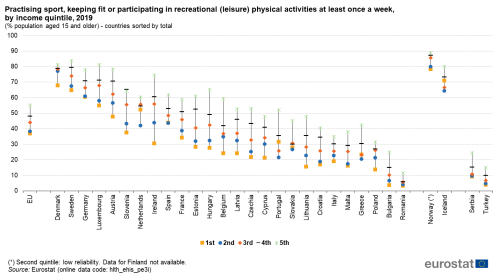
(% population aged 15 and older) – countries sorted by total
Source: Eurostat (hlth_ehis_pe3i)
Frequency of aerobic physical activity
When evaluating the participation in sport and physical activity, it is also important to consider how often people exercise in a typical week. Regular physical activity can help create a healthy habit. The following part of the article will focus on the distribution of the population according to the time spent on health-enhancing (non-work-related) aerobic physical activity (in minutes per week). Physical activities included are sports and cycling as a mode of transport.
One third of Europeans spend at least 150 minutes per week on physical activity
In 2019, at EU level, around one third of the EU population aged 15+ spent at least 150 minutes per week on aerobic physical activity (see Figure 4): this percentage was over half of the population in the Netherlands (62 %), Sweden (56 %) and Denmark (55 %). On the other hand, this percentage was under one quarter in 11 EU countries, with lowest values in Malta (12 %), Bulgaria (11 %) and Romania (8 %).
In 6 countries, there were relatively more people who spent at least 150 minutes per week on aerobic physical activity than people who declared they never did any activity.
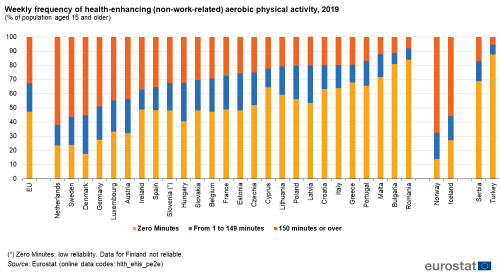
(% population aged 15 and older)
Source: Eurostat (hlth_ehis_pe2e)
Men generally engage in physical activity more often than women
In 2019, 37 % of men in the EU reported at least 150 minutes of aerobic physical activity per week, as opposed to 29 % of women. Only in Denmark and Sweden was this pattern reversed, with women practising more frequently than men (see Table 3). On the other hand, this gender gap was more than 10 pps in five EU countries (France, Slovakia, Czechia, Spain and Bulgaria – in the latter, the percentage of men practising for at least 150 minutes per week was almost 3 times higher than for women exercising as often). Further analysis is needed on the underlying reasons for this large gender difference.
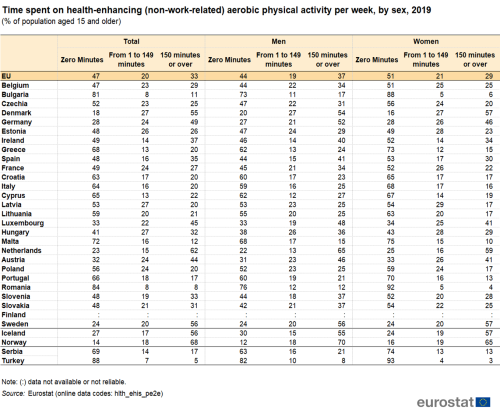
(% of population aged 15 and older)
Source: Eurostat (hlth_ehis_pe2e)
People with a high level of educational attainment spend more minutes on physical activity
Educational background is another factor which can contribute to explaining the differences in terms of weekly frequency of aerobic physical activity.
In 2019, across the EU, 42 % of the population with post-secondary education (levels 5-8 in the international standard classification of education [ISCED]) spent at least 150 minutes per week on aerobic physical activity: this percentage fell to 33 % for people with a secondary level of educational attainment (ISCED levels 3-4) and further dropped to 25 % for people who completed at most a lower secondary level of educational attainment (ISCED levels 0-2) (see Figure 5).
The biggest discrepancies between ISCED levels were recorded in Ireland and Austria, with 27 and 25 pps respectively, between people with a post-secondary and at most a lower secondary level of educational attainment. On the other hand, Lithuania was the only EU country where the same percentage of people with a high and low level of education spent at least 150 minutes per week on aerobic physical activity.
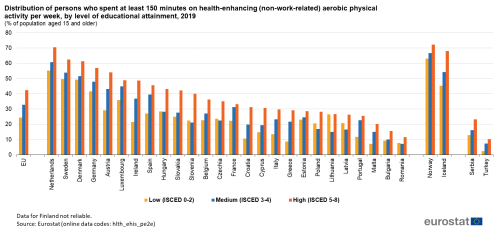
(% population aged 15 and older)
Source: Eurostat (hlth_ehis_pe2e)
Young people (15-29 years-old) with high frequency of physical activity less influenced by their income level
Figure 3 shows that lower income could influence the participation in sport, fitness or recreational (leisure) physical activities. The following figure focuses on people aged 15-29, who are usually more active, and here the income quintile doesn’t seem to create many disparities regarding the time spent on aerobic physical activity per week, at least for people with higher participation rates (150 minutes or more per week).
At EU level, the share of the population aged 15-29 who belong to the 5th income quintile with at least 150 minutes of physical activity per week was 52 %, only five pps higher than the ones who belong to the 1st and 2nd income quintiles (see Figure 6).
At national level, while this income difference is still low for the countries with the highest percentages of young people who exercise (the Netherlands, Germany and Denmark), for others the difference can be higher than 20 pps. This was the case for Ireland (28 pps between fifth and first income quintiles), Bulgaria and Belgium (27 pps) and Luxembourg (25 pps). In Poland and Latvia, the percentage of young people with at least 150 minutes of physical activity per week was higher in the first income quintile than in the fifth quintile.
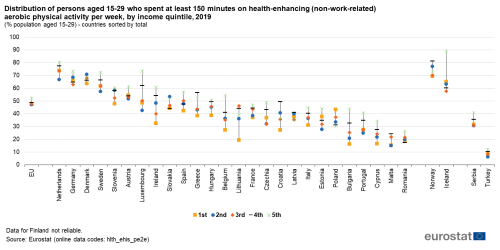
(% population aged 15-29) – countries sorted by total
Source: Eurostat (hlth_ehis_pe2e)
Source data for tables and graphs
Data sources
Eurostat’s sports statistics are derived from existing EU surveys, as to date there has been no dedicated data collection for sport at EU level.
Data on people’s active involvement in sport come from wave 3 of the EHIS module on physical activity, which was run around 2019. The survey gathered data on work and non-work related physical activity. For sports statistics purposes, only the latter was taken into account.
The data presented in this article refer only to engaging in sport, fitness or recreational activities (e.g. Nordic walking, brisk walking, ball games, jogging, cycling, swimming, aerobics, rowing, badminton, etc.). The reference period is a typical 7-day week and the target population consists of people aged 15 and over.
Context
EU-level cooperation and dialogue on sport has improved greatly since 2007, when the Commission adopted a White Paper on Sport — the first sports policy document published by the EU.
With the ratification of the Lisbon Treaty in 2009, sport became an area where the EU has ‘supporting, coordinating and supplementing’ powers. For the first time, the EU was actively aiming to promote sport and physical activity at policy level — not only to improve health and physical well-being across the EU, but also to enhance the role that sport can play in boosting social cohesion and for its educational value.
The multiannual work programmes (EU Work Plan for Sport for 2014–2017; EU Work Plan for Sport 2017–2020; EU Work Plan for Sport 2021–2024) represent a tangible example of the importance that sport has gained in European policy initiatives. These programmes, agreed by the Council, set the priorities and the principles for cooperation between the European Commission and EU countries in the field of sport.
In addition, in 2012 the Council adopted conclusions on promoting health-enhancing physical activity and strengthening the evidence base for sport policy making; it called on the Commission to issue regular surveys on sport and physical activity. The 2013 Council Recommendation on health-enhancing physical activity (HEPA) sought to encourage more effective policies and cooperation among all sectors that have a role to play in this field, i.e. sport and health, but also education, urban planning and the work environment.
Among other EU initiatives aimed at encouraging people to engage more in sport and physical activity, the Commission established the annual European Week of Sport from 2015 to promote sport and physical activity across Europe.

